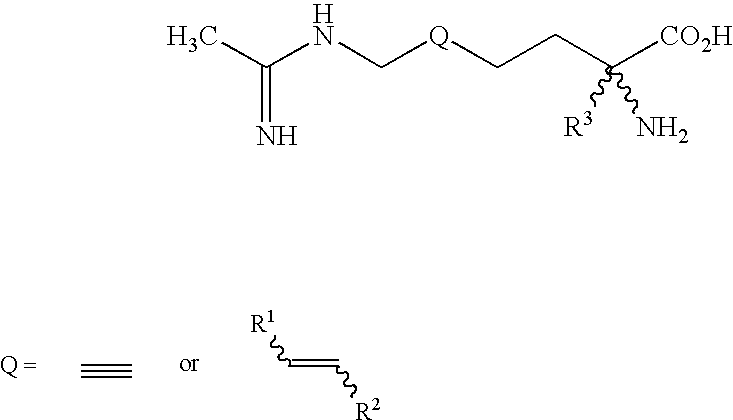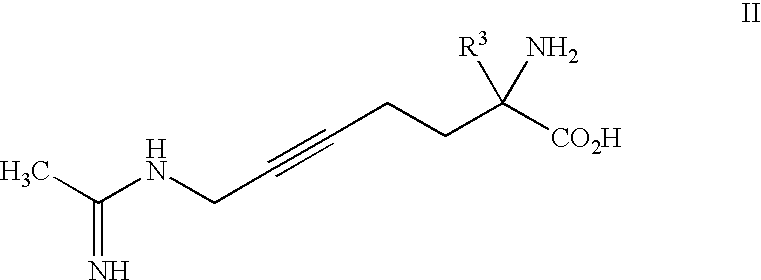2-amino-2-alkyl-5 heptenoic and heptynoic acid derivatives useful as nitric oxide synthase inhibitors
a technology of nitric oxide synthase and derivatives, which is applied in the direction of group 3/13 element organic compounds, immunological disorders, metabolism disorders, etc., can solve the problem of unfavorable conformational rigidity with one or more carbon-carbon double bonds, and achieve the effect of reducing the risk or severity of opioid side effects
- Summary
- Abstract
- Description
- Claims
- Application Information
AI Technical Summary
Benefits of technology
Problems solved by technology
Method used
Image
Examples
example 1
[0469]
(2S,5E)-2-amino-2-methyl-6-fluoro-7-[(1-iminoethyl)amino]-5-heptenoic acid, Dihydrochloride
[0470]
example-1a
[0471]To a cold (−78° C.) solution of triethyl 2-fluorophosphonoacetate (25.4 g, 105 mmol) in 100 mL of THF was added n-butyl lithium (63 mL of 1.6 M in hexane, 101 mmol). This mixture was stirred at −78° C. for 20 mnin producing a bright yellow solution. A solution of crude 3-[(tert-butyldimethylsilyl)oxy]propanal (J. Org. Chem., 1994, 59, 1139-1148) (20.0 g, 105 nunol) in 120 mL of THF was then added dropwise over ten minutes, and the resulting mixture was stirred for 1.5 h at −78° C., at which time analysis by thin layer chromatography (5% ethyl acetate in hexane) showed that no starting material remained. The reaction was quenched at −78° C. with sat. aqueous NHCl (150 mL). The organic layer was collected, and the aqueous layer was extracted with diethyl ether (300 mL). The combined organics were washed with brine (200 mL), dried over MgSO4, filtered and concentrated. The crude material was filtered through a plug of silica gel (150 g) eluting with hexane (2 L) to give 14.38 g (...
example-1b
[0473]To a solution of Example-1A (6.76 g, 24.5 mmol) in 100 mL of methanol at room temperature was added solid NaBH4 (4.2 g, 220 mmol) in 1.4 g portions over three hours. After 3.5 hours water was added (10 mL). Additional solid NaBH4 (4.2 g, 220 mmol) was added in 1.4 g portions over three hours. The reaction was quenched with 150 mL of sat. aqueous NU4Cl and extracted with diethyl ether (2×250 mL). The organic layers were combined, dried over MgSO4, filtered and concentrated. The crude material, 4.81 g of clear oil, was purified by flash column chromatography on silica gel eluting with 10% ethyl acetate in hexane to give 2.39 g (42%) of the desired (2E)-5-[[(1,1-dimethylethyl)dimethylsilyl]oxy]-2-fluoro-2-penten-1-ol product as a clear oil, that contained an approximate E:Z ratio of 93:7 by 19F NMR.
[0474]HRMS calcd. for C11H24FO2Si: m / z=235.1530 [M+H]+, found: 235.1536. 1H NMR (CDCl3) δ 0.06 (s, 6H), 0.88 (s, 9H), 2.35 (m, 2H), 3.62 (t, 2H), 4.19 (dd, 2H), 5.2 (dt, vinyl, 1H). 19...
PUM
 Login to View More
Login to View More Abstract
Description
Claims
Application Information
 Login to View More
Login to View More - R&D
- Intellectual Property
- Life Sciences
- Materials
- Tech Scout
- Unparalleled Data Quality
- Higher Quality Content
- 60% Fewer Hallucinations
Browse by: Latest US Patents, China's latest patents, Technical Efficacy Thesaurus, Application Domain, Technology Topic, Popular Technical Reports.
© 2025 PatSnap. All rights reserved.Legal|Privacy policy|Modern Slavery Act Transparency Statement|Sitemap|About US| Contact US: help@patsnap.com



